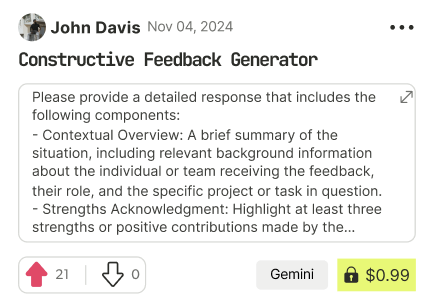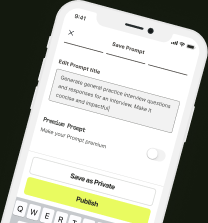prompt mine App
Find, Create & Share AI Magic
Optimizing Subscription Services for Financial Efficiency
Step 1: Gather Information on Current Subscriptions
Compile a comprehensive list of all subscription services, including:
+ Streaming services (e.g., Netflix, Hulu, Amazon Prime)
+ Software tools (e.g., Adobe Creative Cloud, Microsoft Office 365)
+ Magazines (e.g., print, digital, or both)
+ Music services (e.g., Spotify, Apple Music)
+ Online courses or educational platforms (e.g., Udemy, Coursera)
+ Membership programs (e.g., gym memberships, wine clubs)
+ Cloud storage services (e.g., Google Drive, Dropbox)
+ Productivity apps (e.g., Evernote, Trello)
Record the following details for each subscription:
+ Name and type of subscription
+ Monthly or annual cost
+ Date of last use or access
+ Frequency of use (e.g., daily, weekly, monthly)
Step 2: Evaluate Necessity and Usage Patterns
Review your list of subscriptions and assess the following:
+ How often do you use each service?
+ Are there any duplicate or redundant services?
+ Are there any services that can be replaced with free alternatives?
+ Are there any services that can be negotiated for a better rate?
Categorize your subscriptions into three groups:
+ Essential (used frequently, essential for daily life or work)
+ Nice-to-have (used occasionally, but not essential)
+ Underutilized (rarely used or not providing value)
Step 3: Eliminate or Negotiate Underutilized Subscriptions
Identify underutilized subscriptions and consider the following strategies:
+ Cancel subscriptions that are no longer needed or used
+ Downgrade or adjust subscription plans to a lower tier or frequency
+ Negotiate with service providers for a better rate or promotional offer
+ Consider alternatives or competitors that offer better value
Contact service providers to request cancellation, downgrades, or rate negotiations, and be prepared to explain your reasons and desired outcomes
Step 4: Track Subscriptions and Expenses
Set up a system to track and monitor your subscription services and expenses:
+ Use a spreadsheet or budgeting app (e.g., Mint, Personal Capital) to record and categorize your subscriptions
+ Set reminders for subscription renewal dates and rate changes
+ Regularly review and update your list of subscriptions to ensure accuracy and relevance
Consider implementing a subscription "expiration date" to evaluate and re-evaluate services on a regular basis (e.g., every 3-6 months)
Recommended Tools and Apps
Budgeting and expense tracking:
+ Mint
+ Personal Capital
+ YNAB (You Need a Budget)
Subscription management:
+ Trim
+ Truebill
+ Subscription Manager
Cloud storage and organization:
+ Google Drive
+ Dropbox
+ Microsoft OneDrive
Implementation Plan
1. Gather information on current subscriptions (1-2 hours)
2. Evaluate necessity and usage patterns (1-2 hours)
3. Eliminate or negotiate underutilized subscriptions (1-3 hours)
4. Set up subscription tracking and expense monitoring system (1-2 hours)
5. Regularly review and update subscription list and budget (30 minutes-1 hour every 3-6 months)
By following this step-by-step plan, you can optimize your subscription services for financial efficiency, eliminate underutilized subscriptions, and develop a system for tracking and managing your expenses effectively.

Optimizing Subscription Services for Financial Efficiency


Find Powerful AI Prompts
Discover, create, and customize prompts with different models, from ChatGPT to Gemini in seconds

Simple Yet Powerful
Start with an idea and use expert prompts to bring your vision to life!